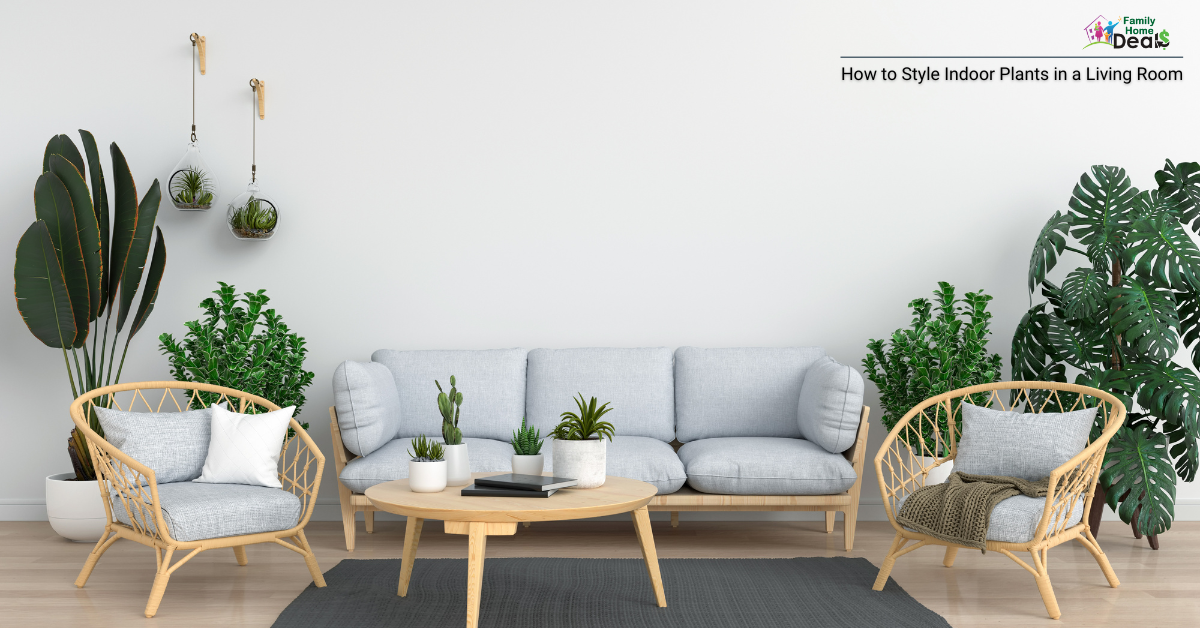
Indoor plants have become a staple in modern home decor, especially in living rooms, where they breathe life into the space and add a touch of natural beauty. But how do you style indoor plants in a way that elevates your living room’s aesthetic without overwhelming it? And what color scheme best complements the greenery? If you’re ready to transform your space, keep reading for practical tips, color suggestions, and eight decoration ideas that will help you master the art of styling a living room with plants.
Decorating your living room with plants is more than just placing a few potted greens around the room. The key is to find balance—both in the plants you choose and how they blend into the existing design. With the right strategies, indoor plants can soften harsh lines, add texture, and even create a relaxing atmosphere that everyone will enjoy. From choosing the perfect spots to deciding which colors pair best with your green companions, this article covers all you need to know.
Tips For Styling a Living Room with Indoor Plants
1. Choose Plants That Match Your Living Room’s Aesthetic
First things first: the type of plants you select matters. While all plants add freshness to a living room, not every plant fits every design style. For instance, modern living rooms with clean lines and minimalist decor look stunning with structured plants like snake plants or ZZ plants. These plants have a sleek, architectural vibe that complements contemporary spaces. On the other hand, more relaxed, boho-style living rooms may look better with trailing plants like pothos or ferns, which add a lush, organic feel.
2. Utilize a Variety of Sizes and Shapes
A well-balanced living room with plants incorporates greenery of different sizes and shapes. Mix large statement plants, like a fiddle-leaf fig or monstera, with smaller tabletop options like succulents or peace lilies. This variation prevents the room from looking too uniform or cluttered.
By including a range of plant sizes, you can create visual interest at different heights, from floor to ceiling. For instance, a tall floor plant in the corner adds drama, while small cacti or aloe plants on a coffee table provide a neat, unobtrusive accent.
3. Create Plant Groupings for Impact
Placing plants together in groups of three or more makes for a striking display. Rather than scattering individual plants around the living room, group them by size, height, or even pot style. For example, you could combine a tall snake plant with a mid-height fern and a small, trailing pothos. Groupings not only make the space look more intentional but also give the plants a stronger visual presence.
4. Use Plants as Natural Room Dividers
If you have an open-concept living room, plants can double as natural dividers. Tall, bushy plants like bamboo or a large palm can act as barriers that section off different areas, like separating the living room from the dining area or an office space. These natural dividers maintain the open feel while giving each area its own identity.
5. Highlight Architectural Features
Got a window seat or a built-in shelf? Use these areas to your advantage! These architectural features make the perfect homes for small plants. A sunlit window is ideal for light-loving plants like succulents, while shelves can be adorned with cascading plants such as string of pearls. The trick is to enhance what’s already in your room by adding plants in a way that complements the space.
6. Choose Stylish Planters to Match Your Decor
Don’t underestimate the power of a good planter. Whether it’s a sleek, modern pot or a woven basket, the planter you choose can elevate the entire look of your living room with plants. If your living room has a more rustic vibe, terracotta pots or ceramic planters with earthy tones will look natural and fitting. For minimalist spaces, white or matte black pots offer a clean, sophisticated feel.
7. Take Advantage of Vertical Space
Don’t forget to think upwards when styling your living room. Hanging plants or vertical plant shelves are a great way to bring greenery into smaller spaces without taking up valuable floor space. Plants like trailing ivy or string of hearts can be hung from the ceiling, while wall-mounted shelves can showcase succulents or ferns. This strategy works wonders in maximizing the greenery in a compact room.
8. Rotate Plants for Freshness and Health
To keep your living room with plants looking fresh and lively, regularly rotate your plants. This will prevent any one plant from getting too much or too little sunlight and will help keep the space visually dynamic. Rotating your plants also gives you the chance to mix things up and see which arrangement works best for your style.
What Color Is Best for a Living Room with Plants?
Choosing the right color scheme is crucial when decorating a living room with plants. You want colors that enhance the natural beauty of the greenery, not overpower it. Here are some top choices:
1. Neutral Shades: Beige, cream, light gray, or soft taupe are excellent neutral tones that provide a soothing backdrop for plants. These colors create a calm, inviting atmosphere while allowing the green from the plants to pop. Neutral shades also give you flexibility when it comes to furniture and accessories, letting the plants shine without distraction.
2. Earthy Tones: Earthy shades like terracotta, warm browns, or muted mustard bring out the natural elements of plants. These tones work especially well if you’re aiming for a cozy, grounded look. Pairing green plants with these colors creates a warm, homey vibe that feels connected to nature.
3. Soft Pastels: For a more delicate touch, consider pastels like blush pink, mint green, or pale lavender. These soft hues add a hint of color without clashing with the plants. Pastels are ideal for a more feminine or airy living room with plants and can make the space feel light and fresh.
4. Deep Greens and Blues: If you’re feeling bold, deep greens or rich navy blues can complement plants beautifully. Dark walls with lush greenery create a striking contrast that’s both dramatic and sophisticated. This combination works best in rooms with plenty of natural light to prevent the space from feeling too dark.
8 Home Decoration Ideas Using Indoor Plants
1. Plant Stand Display
Instead of placing plants directly on the floor or furniture, invest in a few stylish plant stands to elevate your greenery. Plant stands are an excellent way to add dimension and height variation to your living room. Opt for tiered stands that allow you to arrange plants at different levels, creating a layered effect.
This method is particularly effective in smaller spaces, as it adds vertical interest without taking up too much floor space. You can go for stands in natural materials like wood or wicker for a cozy vibe, or sleek metal and glass options for a more modern touch. To add even more personality, mix plant varieties—combine a tall snake plant on the top tier with a medium-sized monstera and a trailing pothos on the lower levels.
2. Hanging Garden
Maximize your living room’s vertical space by installing hanging pots with trailing plants. Hanging plants like string of pearls, ivy, or pothos are perfect for this decor idea. They bring attention upward and make the room feel taller and airier. Hanging plants are also ideal for small living rooms where floor space is limited. To create a stunning hanging garden, choose plants that thrive in the light conditions of your room. Place them near windows or above seating areas for a more dramatic effect. You can also experiment with macrame plant hangers or minimalist ceramic pots suspended from the ceiling. This not only keeps your plants off surfaces but adds an artistic, boho-inspired element to your space.
3. Bookshelf Jungle
Turn your bookshelf into a mini indoor garden by incorporating small plants among your books and decor. A bookshelf jungle can breathe life into an otherwise static feature of your living room. Mix and match plant varieties like trailing vines, such as philodendron or pothos, to cascade over the edges of the shelves. Place small potted succulents, cacti, or air plants on top of your books for a layered effect.
For a cohesive look, consider color-coordinating your pots with the tones of your books or other decor items. You can also tuck in a few decorative items like candles or framed photos to create a balanced, eclectic display. The greenery will soften the hard lines of your shelves and make the room feel more organic and lively.
4. Coffee Table Centerpiece
For an understated but impactful plant display, place a single potted plant as the centerpiece on your coffee table. A low-maintenance plant like a succulent, cactus, or peace lily works well, as it doesn’t require constant care. To ensure that the plant enhances rather than overwhelms your coffee table setup, choose one with a clean, simple pot that complements your other decor. You can pair it with a stack of books, a tray, or a candle to create a balanced and visually appealing arrangement. This small addition brings a touch of nature to the center of your living room and serves as a conversation piece without being too showy.
5. Windowsill Herb Garden
If your living room has a sunny window, take advantage of the natural light by growing an herb garden on the windowsill. Not only do herbs like basil, mint, rosemary, and thyme add a pop of green, but they’re also functional—you’ll have fresh herbs for cooking right at your fingertips! Use a collection of matching small pots for a clean, uniform look, or mix different styles for a more eclectic aesthetic. Consider labeling each pot with the herb’s name for a cute, personalized touch. Windowsill herb gardens work especially well in small spaces where floor or tabletop room is limited. Plus, the smell of fresh herbs can add an inviting fragrance to your living room.
6. Corner Statement Plant
Every living room has that one forgotten corner that could use a little love, and nothing brightens up a space like a statement plant. Large plants like a fiddle-leaf fig, rubber tree, or bird of paradise are perfect for filling an empty corner and making it a focal point. These plants add height, drama, and a splash of lush green, drawing attention to a part of the room that might otherwise go unnoticed. For added effect, place the plant in a decorative pot or basket that complements your decor. You can also position it near a piece of furniture like a reading chair or a side table to create a cozy, inviting nook.
7. Mixed Pot Textures
One way to make your living room plant display more interesting is by mixing and matching the textures of your plant pots. Don’t feel limited to one style—use woven baskets, ceramic pots, terracotta containers, or even metallic planters to create variety. The key is to ensure that the pots complement each other in terms of color or shape while adding depth and contrast to your overall decor. For example, you might pair a smooth, modern ceramic pot with a rustic, rough-hewn terracotta one for an appealing contrast.
This idea works well on a coffee table, bookshelf, or plant stand, adding a sense of depth and visual interest to the space. Playing with textures keeps the decor dynamic and layered, making the room feel more curated and intentional.
8. Mantel Greenery
If your living room has a fireplace, it offers the perfect opportunity to showcase some greenery on the mantel. Small potted plants like succulents, ferns, or trailing vines can soften the typically hard, linear structure of the fireplace. For a balanced look, arrange plants of varying heights along the mantel. You could place taller plants on the ends and fill in the middle with smaller, more delicate options.
Trailing plants like ivy or strings of hearts can cascade over the edge for added movement and texture. This arrangement not only brings life to the mantel but also enhances the cozy atmosphere of the room, especially when paired with the warmth of a fire during the colder months. You can mix plants with candles, vases, or framed artwork to create a stylish, well-rounded display.
10 Best Low Maintenance Indoor Plants for Your Living Room
Not everyone has the time or the know-how to care for demanding plants. Fortunately, plenty of low-maintenance options are perfect for a living room with plants. These are easy to care for and hardy enough to survive with minimal attention:
- Snake Plant (Sansevieria): Known for its tall, upright leaves, this plant is incredibly resilient. It thrives in low light and only needs watering once every two weeks.
- ZZ Plant (Zamioculcas zamiifolia): This plant can tolerate low light and drought, making it one of the most low-maintenance options. Its glossy leaves add elegance to any living room.
- Spider Plant (Chlorophytum comosum): A great beginner plant, the spider plant is known for its ability to purify air and grow quickly. It does well in indirect sunlight and only requires watering when the soil feels dry.
- Pothos (Epipremnum aureum): Pothos is a trailing plant that grows well in almost any condition, including low light. It can tolerate a missed watering or two, making it perfect for busy households.
- Peace Lily (Spathiphyllum): Known for its lovely white blooms, the peace lily thrives in indirect light. It prefers moist soil but will recover quickly even if you forget to water it for a few days.
- Aloe Vera: A sun-loving plant that requires little watering. Aloe Vera not only looks great but also provides soothing gel for burns and cuts—double duty as decor and medicine!
- Rubber Plant (Ficus elastica): This plant has large, glossy leaves that can grow quite tall. It thrives in bright, indirect light and prefers to dry out between waterings.
- Philodendron: Like the pothos, philodendrons are trailing plants that do well in low light. They are forgiving plants and grow quickly with minimal care.
- Succulents: If you’re really forgetful when it comes to watering, succulents are your best bet. These small plants store water in their leaves and thrive in dry environments with plenty of sunlight.
- Cast Iron Plant (Aspidistra elatior): True to its name, this plant is virtually indestructible. It can handle neglect, low light, and infrequent watering, making it ideal for plant newbies.
Create a living room that feels fresh and effortlessly stylish.
Styling a living room with plants is an easy and rewarding way to elevate the ambiance of your space. Whether you’re working with a small apartment or a large open floor plan, the right combination of plants and thoughtful placement can bring life, color, and texture into any room. From choosing the best plants for your decor style to experimenting with different planters and arrangements, there are endless ways to incorporate greenery into your living space.
In terms of color, the best shades for a living room with plants tend to be neutrals, earthy tones, or even deep blues and greens for those who like a bolder look. These colors allow the plants to be the star while setting the tone for a cozy, inviting atmosphere. Whether you’re a plant enthusiast or just beginning to experiment with greenery in your home, these tips will help you create a living room that feels fresh, balanced, and effortlessly stylish.


